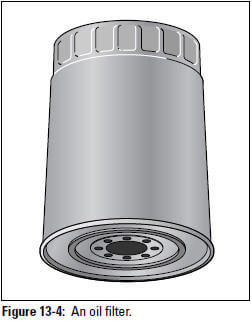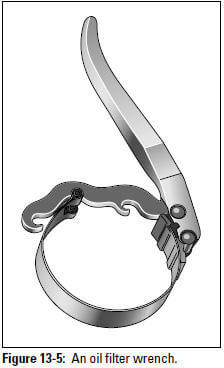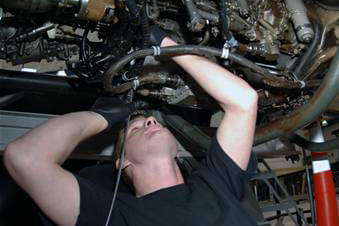Changing oil is usually easy. In fact, unless it's impossible to reach your oil filter and/or oil drain plug, you have good reasons to change your oil and oil filter yourself: It's cheaper, you know that the job's being done right, and it requires little time or effort. (During one of my TV guest appearances, Regis Philbin changed the oil in a car in five minutes, and he didn't get a spot on his Italian silk suit!) All you have to do is unscrew a plug and a filter, let the oil drain out, replace the filter and plug, and pour in some new oil.
 |
If you have a professional do it for you, you have to telephone the shop to make an appointment, drive the car in, either wait for it or find a ride home and back again to pick it up, and then wait until they write up your bill — all of which takes much longer than changing your oil yourself. If you go to one of those quickie oil change places, you don't know what viscosity and grade of oil they've really used, whether they really changed the filter, and whether the drain plug was secured properly. (If you don't think that's a problem, check out the nearby sidebar "A tragic tale"!) Most important, when you see how inexpensive and easy it is to do this job yourself, you'll change your oil as often as necessary rather than adding visits to the service station to your procrastination list!
|
A tragic tale Before I stopped being an automotive "dummy," my family car, Big Green Feller, resided for its first 35,000 miles in a commercial garage where professional mechanics looked after it. Whenever they said that the car needed the oil changed, I scheduled the work promptly. Yet when I took the engine apart in an adult-education automotive class, I found that the mechanics had never changed the oil! This lack of proper lubrication had led to big trouble: The dirty old oil had formed big, black pebbles, and the camshaft had practically worn away! When this happens, either you opt for major and expensive surgery or you get rid of the vehicle. As I sadly watched Big Green Feller vanish into the sunset, the major question on my mind was, "How did this happen?" The answer, unfortunately, was that I'd depended on someone else for lubrication reminders and had trusted someone else to do the job properly. Not only had I been paying at least twice as much as it would have cost to do the job myself, but I ended up paying to replace a car that could have gone almost twice as far if it had been lubricated properly. |
 |
Tip: If you can't reach the oil filter or drain plug without having to crawl under your vehicle, or if you want to chicken out of the job for any other reason, most shops regularly offer low-priced specials for changing oil or include it in maintenance packages. Just be sure that they use the right grade of highquality oil for your vehicle and that they change the oil filter, too. To be sure they've replaced the drain plug, drive the car off the spot where they've parked it and look for fresh oil on the ground that was under it. Paranoid? Maybe, but if the oil drains out while you're driving, you could ruin the enginein a matter of blocks.
Get your supplies together
Before you start the job, assemble the following items:
- Oil: Check your owner's manual to find the proper oil viscosity recommended for your vehicle and the number of quarts you need. (As a general rule, most vehicles require five to six quarts of oil, but you don't want to risk overfilling it.) If you have no manual, call a local dealer who sells your vehicle's make and model and ask someone in the service department. Or find the information at your local library in a service manual for your vehicle's make, model, and year.
- An oil filter: Under the hood of most cars, sticking out of the engine is what looks like a tin can screwed into the engine block. This is the oil filter (see Figure 13-4). As the oil circulates from the oil pan through your engine, it passes through this filter, which cleans the oil andremoves some of the particles of metal and dirt. Change the oil filter every time you change your oil,especially if you do it less frequentlythan every 5,000 miles.Oil filters sell for very little atauto supply stores (at a servicestation, you'll usually pay more).
Tip: Check the price of an oil filter atyour dealer's parts department.If it's within a dollar or two ofthe auto parts store price, buyit. It's probably a better filter.(Some of the auto parts store filtersare very cheaply made, andthey fail occasionally.) Makesure to get the right filter foryour vehicle's make and model!
- An oil filter wrench (optional):Most oil filters screw on and off.If your old filter hasn't beenchanged in a long time, you mayneed an oil filter wrench, like the one shown in Figure 13-5, to unscrewyour filter. Always tighten the new filter by hand to avoid crushing the seal.
- An adjustable wrench: Use this toolto unscrew the oil drain plug.
- A screwdriver: Select one that'sstrong enough to punch a hole in anoil filter (you'll find out why later on).
- An oil drain plug gasket: If you buyyour oil filter from a dealership, anew gasket may be in the package. Ifit isn't, get a gasket for your vehicle'smake, model, and year.
Some vehicles don't have drain pluggaskets, relying instead on a taperedmetal-to-metal contact to prevent oilleakage. Don't try to use a gasket onone of these arrangements. It won'twork, and you may end up with yournew oil in a pool on the floor.
- A drain pan to catch the oil: Find anold basin that's low enough to fitunder your vehicle's drain plug withoutthe necessity of jacking up the car, and large enough to hold all theold oil — usually about five quarts. Line the basin with a heavy-duty plastic garbage bag, opened so that it can catch the oil, leaving the basinclean.
Tip: You can buy a container made especially for catching old oil. These containersare reusable, but you have to wash them out and find a place tokeep them, or throw them out and buy another one each time. Moreimportant, you can't recycle the oil that's drained into them.
- A funnel: Oil is sold in containers that have narrow necks to facilitatepouring the oil into the engine. If you're still worried about your aim, usea funnel to prevent messy spills. The funnel also comes in handy fordecanting the used oil into containers for recycling.
- Thin disposable plastic gloves to keep your hands clean: You also canuse dish detergent to easily remove oil from your hands.
- Things to clean up oil: You should have a clean, lint-free rag handy forwiping your oil dipstick and a dirty, old, thick rag that you don't mindthrowing away to use on spills and tools. You can use paper towels toclean up spills and tools, but don't risk bits of paper getting into yourengine by using paper to tidy it up. (If you own a cat, kitty litter is thebest way to sop up spills on the ground, but not on the engine.)
- A work light: A work light helps you see better underneath the vehicle;a flashlight can be awkward if you have to hold it between your teeth!
From Auto Repair for Dummies, copyright © 2009 by Wiley Publishing, Inc., Indianapolis, Indiana. Used by arrangement with John Wiley & Sons, Inc.










